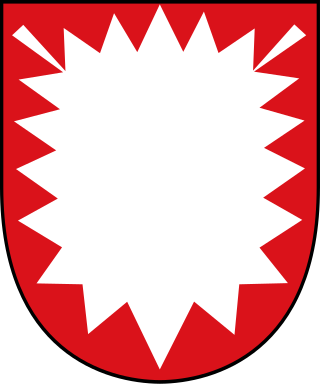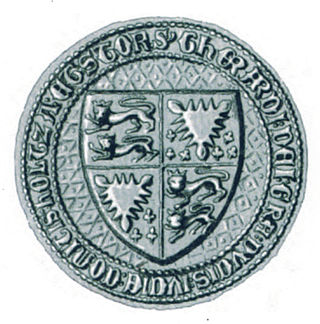The imperial county of Holstein-Kiel was a line of the House of Schauenburg and Holstein from 1261 to 1390.
The imperial county of Holstein-Kiel was a line of the House of Schauenburg and Holstein from 1261 to 1390.
The County of Holstein was ruled until 1238 by Adolphus IV of Schauenburg and Holstein. When he retired, his sons John I and Gerhard I ruled jointly in Holstein. In 1261 they divided the county, John taking Kiel and founding the line of Holstein-Kiel, and Gerhard taking Itzehoe and founding the Holstein-Itzehoe line.
In 1300 Holstein-Itzehoe was further divided into Holstein-Plön, Holstein-Pinneberg and Holstein-Rendsburg.
In 1350 the County of Holstein-Plön fell to the counts of Holstein-Kiel.
In 1390 the last Count of Holstein-Kiel, and hence of Holstein-Plön, died without issue. Both counties were inherited by the line of Holstein-Rendsburg.
Following the death of John I, his sons, Adolphus V and John II ruled Holstein-Kiel jointly. In 1273, they divided Holstein-Kiel, John II ruling from Kiel; Adolphus V ruling from Segeberg and founding the line of Holstein-Segeberg. When Adolphus V died in 1308 without a male heir, Holstein-Segeberg returned to Holstein-Kiel.
The successor of John II in 1316 was John III, a son of Gerhard II of Holstein-Plön.
After the death of Count Gerhard V of Holstein-Plön, a nephew of John III, the Plön main line ended in 1350 and so John III took over the County of Holstein-Plön.
When Adolphus VII died without heirs in 1390, Holstein-Kiel and Holstein-Plön went into the hands of Count Gerhard VI of Holstein-Rendsburg.
| Holstein | |||||||||||||||||||||||||||||||||
| Holstein-Kiel (1261–1390) | Holstein-Itzehoe (1261–1300) | ||||||||||||||||||||||||||||||||
| Holstein-Segeberg (1273-1308) | |||||||||||||||||||||||||||||||||
| Holstein-Plön (1300–1390) | Holstein-Rendsburg (1300–1459) | Holstein-Pinneberg (1300–1640) | |||||||||||||||||||||||||||||||
| Duchy of Holstein (from 1474) | |||||||||||||||||||||||||||||||||
| Imperial County of Rantzau (1650–1726) | |||||||||||||||||||||||||||||||||

Holstein is the region between the rivers Elbe and Eider. It is the southern half of Schleswig-Holstein, the northernmost state of Germany.

John III of Holstein-Plön, called John the Mild, was a Count of Schauenburg and Holstein-Plön and Holstein-Kiel, ruling Holstein-Plön and Holstein-Kiel (1316–1359). Together with Count Gerhard III of Holstein-Rendsburg, John III was the lord ruling in guardianship the Danish Duchy of Schleswig 1332–1340. He was known as “John the Mild”.

The Counts of Schauenburg and Holstein were titles of the Holy Roman Empire. The dynastic family came from the County of Schauenburg near Rinteln on the Weser in Germany. Together with its ancestral possessions in Bückeburg and Stadthagen, the House of Schauenburg ruled the County of Schauenburg and the County of Holstein. The comital titles of Holstein were subject to the liege lord, the Dukes of undivided Saxony until 1296, and thereafter the Dukes of Saxe-Lauenburg.

The House of Schaumburg was a dynasty of German rulers. Until c. 1485, it was also known as the House of Schauenburg. Together with its ancestral possession, the County of Schaumburg, the family also ruled the County of Holstein and its partitions Holstein-Itzehoe, Holstein-Kiel, Holstein-Pinneberg, Holstein-Plön, Holstein-Segeberg and Holstein-Rendsburg and through the latter at times also the Duchy of Schleswig.
Adolf IV was a Count of Schauenburg (1225–1238) and of Holstein (1227–1238), of the House of Schaumburg. Adolf was the eldest son of Adolf III of Schauenburg and Holstein by his second wife, Adelheid of Querfurt.

The Kalkberg is a 91-metre-high rock in the center of Bad Segeberg, Schleswig-Holstein, Germany. The name is a misnomer as it is not made of limestone, but from gypsum.

Holstein-Plön was the name of a county ruled by the House of Schauenburg that ruled in Holstein and Stormarn from 1110/11 in the 12th century. The county emerged before 1295 when the County of Holstein-Itzehoe was partitioned after the death of Count Gerhard I of Holstein-Itzehoe into the counties of Holstein-Plön, Holstein-Pinneberg and Holstein-Rendsburg.

Gerhard VI was the Count of Holstein-Rendsburg from 1382, and Duke of Schleswig as of 1386.

Gerhard II of Holstein-Plön, nicknamed the Blind, was Count of Holstein-Plön from 1290 to 1312.

Gerhard I, Count of Holstein-Itzehoe was the only count of Holstein-Itzehoe.

John I, Count of Holstein-Kiel was a member of the House of Schauenburg. He was Count of Holstein-Kiel from 1261 until his death.

John II, nicknamed the one-eyed (1253–1321) was the ruling count of Holstein-Kiel from 1263 to 1316.

Nicholas, Count of Schauenburg and Holstein-Rendsburg was a titular Count of Schauenburg. Together first with his brother and then with his nephews, Nicholas was the co-ruling Count of Holstein-Rendsburg from 1340 until his death. In 1390 Nicholas and his nephews inherited Holstein-Kiel, which itself included former Holstein-Plön through reversion in 1350. So except of Holstein-Pinneberg Nicholas and his nephews had united all of Holstein. He was also co-ruler of Schleswig from 1375 to 1386. He was thus a leading member of the House of Schauenburg and an influential figure in the area north of the Elbe. He was the second son of Count Gerhard III of Holstein-Rendsburg and his wife, Sophia of Werle.
Adolph IX, Count of Holstein-Kiel, also known as Adolph VII, was count of Holstein-Kiel and Holstein-Plön from 1359 until his death.

Adolph V, Count of Holstein-Segeberg was the ruling count of Holstein-Kiel from 1263 to 1273 and of Holstein-Segeberg from 1273 until his death.

Holstein-Rendsburg is the name of a county that existed from 1290 to 1459, ruled by a line of the Schauenburg family.
Holstein-Itzehoe was a county that was formed from Schauenburg and Holstein by the division of Holstein between Gerhard and John in 1261.

The County of Holstein-Pinneberg, also known as the County of Schauenburg and Holstein-Pinneberg, was a small territory which existed from 1290 until 1640, centred around Pinneberg in modern-day Schleswig-Holstein, Germany.
The County of Holstein-Segeberg was a county in the state of Holstein from 1273 to 1308 and a line of the noble family of Schauenburg and Holstein. The only count of Holstein-Segeberg was Adolphus V, nicknamed the Pomeranian, who was born in 1252 and died in 1308.